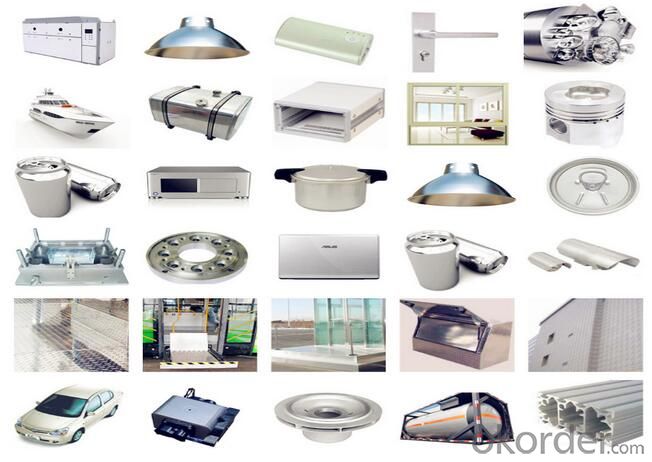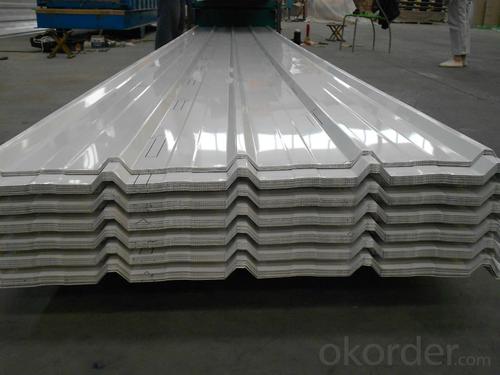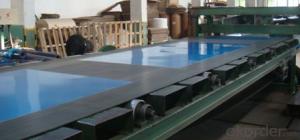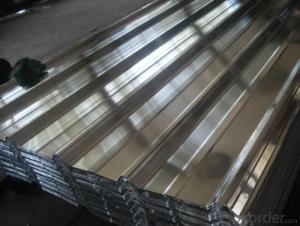Aluminum 4 X 8 Sheets - Corrugated Aluminum Plate in Different Corrugation Profiles
- Loading Port:
- Tianjin
- Payment Terms:
- TT OR LC
- Min Order Qty:
- 5 m.t.
- Supply Capability:
- 60000 m.t./month
OKorder Service Pledge
OKorder Financial Service
You Might Also Like
Specification
Corrugated Aluminum Plate in Different Corrugation Profiles
Specifications
Alloy NO. | Thickness | Width | Length | Production line | Circulation size |
1050 1060 1100 3003 | 0.3-9.5mm | 800--2200mm | 1000--10000mm | DC,CC | 1220*2440mm 1250*2500mm 1500*3000mm 1000*2000mm
|
5052 5083 5454 5754 5086 | 0.5-150mm | 800--2200mm | 1000--6000mm | DC | |
6061 | 5-150mm | 800--2200mm | 1000--10000mm | DC | |
7075 | 6-150mm | 800--2200mm | 1000--10000mm | DC | |
Packing | Stick blue film→plastic film→waterproof paper→1~2 tons on a export standard pallet(corner protection) | ||||
Application | decoration:ceilings,walls,furniture,cabinets,elevators,signs,name plate, transportation, cookware, household appliances:refrigerators,microwave ovens, machinery, mold making,aerospace and military aspects, auto, PP cap , construction etc | ||||
Standard | Chemical Composite: GB/T 3190-2008, JIS, EN, ASTM | ||||
Mechanical Property: GB/T 3880.2-2012, JIS, EN, ASTM | |||||
MOQ | 5TONS | ||||
Kind attention | Specifications can be customized as the customer’s requirements | ||||
Application

FAQ
Q: Can you provide free samples?
A: Yes, free samples will be sent to you on freight at destination.
Q: Can I get your latest catalogue?
A: Yes, it will be sent to you in no time.
Q: What are your payment terms?
A: We accept L/C, D/A, D/P, T/T, West Union, etc
Q: Can you provide free samples?
A: Yes, free samples will be sent to you on freight at destination.
Q: Can I get your latest catalogue?
A: Yes, it will be sent to you in no time.
Q: What is the MOQ?
A: 5 tons.
- Q: Are aluminum sheets suitable for beverage cans?
- Yes, aluminum sheets are suitable for beverage cans. Aluminum is a widely used material in the beverage industry due to its unique properties. It is lightweight, corrosion-resistant, and provides an excellent barrier against light, oxygen, and moisture, which helps to preserve the quality and freshness of the beverage. Additionally, aluminum is easily formable, allowing for the production of various can shapes and sizes. It is also recyclable, making it an environmentally friendly choice. Overall, aluminum sheets are an ideal material for beverage cans, meeting both functional and sustainability requirements.
- Q: I have an aluminum block engine in my wakeboard boat which is built for the lakes, now i live on salt water and was wondering the effect saltwater would have on the engine block as water goes through to cool it.
- Munch Munch better flush when done.
- Q: Can aluminum sheets be textured or patterned?
- Yes, aluminum sheets can be textured or patterned through various processes such as embossing, engraving, or adding surface finishes like brushed, hammered, or matte patterns.
- Q: Can 101 aluminum sheets be used in the production of nameplates or tags?
- Yes, 101 aluminum sheets can be used in the production of nameplates or tags. Aluminum is a popular material choice for nameplates and tags due to its durability, lightweight nature, and resistance to corrosion. The 101 aluminum alloy, which is a commercially pure aluminum, offers excellent formability and workability, making it suitable for various manufacturing processes such as stamping, engraving, or etching. It can be easily cut, shaped, and customized to create high-quality nameplates or tags with clear and precise markings. Additionally, aluminum's ability to withstand harsh environments and its attractive appearance make it a preferred choice for many industries, including automotive, aerospace, electronics, and signage. Therefore, 101 aluminum sheets are a suitable material for the production of nameplates or tags.
- Q: How do aluminum sheets perform in terms of water resistance?
- Aluminum sheets have excellent water resistance properties. Due to the natural oxide layer that forms on its surface, aluminum is highly resistant to corrosion and effectively prevents the penetration of water. This oxide layer, also known as aluminum oxide, acts as a protective barrier, inhibiting the reaction between aluminum and water molecules. Additionally, aluminum sheets can be further enhanced with different surface treatments, such as anodizing or coating, to improve their water resistance even further. These treatments create a thicker and more durable oxide layer, making the aluminum sheets highly resistant to water damage, moisture, and rust. Overall, aluminum sheets are a reliable choice for applications that require water resistance, ensuring long-lasting performance in various environments.
- Q: Are aluminum sheets suitable for aerospace structural components?
- Aerospace structural components can indeed be made from aluminum sheets. Aluminum is a material that is both lightweight and durable, and it has been used extensively in the aerospace industry for many years. Its exceptional strength-to-weight ratio makes it highly desirable for a range of applications in aircraft manufacturing. Aluminum sheets provide numerous advantages for aerospace structural components. Firstly, their lightweight nature helps to reduce the overall weight of the aircraft. This is crucial for improving fuel efficiency, increasing payload capacity, and enhancing overall performance. Additionally, the lightweight quality of aluminum sheets makes them easier to handle and assemble during the manufacturing process. Secondly, aluminum exhibits excellent resistance to corrosion. This is particularly important for aerospace applications, as the components are exposed to various environmental conditions, such as high humidity, extreme temperatures, and exposure to chemicals. The corrosion resistance of aluminum ensures that the structural components remain durable and long-lasting, reducing the need for frequent maintenance and replacement. Furthermore, aluminum is a highly malleable material, allowing for easy shaping and forming into complex structures. It can be bent, cut, and fabricated with ease to meet specific design requirements, making it versatile for a variety of aerospace applications. The ability to form intricate shapes with aluminum sheets enables engineers to design efficient and streamlined structures, optimizing aerodynamics and minimizing drag. Another advantage of aluminum sheets is their excellent thermal conductivity. This property enables efficient heat dissipation, which is crucial in aerospace applications where components may be exposed to high temperatures generated during flight or engine operation. The thermal conductivity of aluminum helps to prevent overheating and ensures the structural integrity of the components. In conclusion, the lightweight, corrosion resistance, malleability, and thermal conductivity properties of aluminum sheets make them highly suitable for aerospace structural components. These characteristics contribute to the overall performance, efficiency, and safety of aircraft, making aluminum an ideal material for various applications in the aerospace industry.
- Q: Are 101 aluminum sheets suitable for chemical processing environments?
- Yes, 101 aluminum sheets are suitable for chemical processing environments. 101 aluminum is a commercially pure aluminum alloy that offers good corrosion resistance and excellent weldability. It is often used in applications where high corrosion resistance is required, such as chemical processing plants. Additionally, 101 aluminum sheets can be further protected by applying a protective coating or anodizing process, which enhances their resistance to chemicals. Overall, 101 aluminum sheets are a suitable choice for chemical processing environments due to their corrosion resistance and ability to withstand exposure to various chemicals.
- Q: Can aluminum sheets be used for automotive applications?
- Yes, aluminum sheets can be used for automotive applications. Aluminum is lightweight, strong, and has excellent corrosion resistance, making it an ideal material for various automotive components such as body panels, hoods, doors, and engine parts.
- Q: Are aluminum sheets suitable for use in cryogenic environments?
- Certainly, aluminum sheets prove to be a fitting choice for utilization in cryogenic surroundings. With its exceptional thermal conductivity and low density, aluminum emerges as an optimal substance for cryogenic purposes. It can endure exceedingly cold temperatures while maintaining its structural integrity and avoiding noticeable thermal expansion. Moreover, aluminum exhibits commendable resistance against corrosion and can be conveniently fashioned into diverse configurations and sizes. These attributes render aluminum sheets widely employed in cryogenic systems, including cryostats, superconducting magnets, and liquid nitrogen storage tanks.
- Q: Can aluminum sheets be used for electrical enclosures?
- Yes, aluminum sheets can be used for electrical enclosures. Aluminum is a popular choice for electrical enclosures due to its excellent conductivity, corrosion resistance, and lightweight properties. It is a good conductor of electricity, allowing for efficient distribution of electrical current within the enclosure. Additionally, aluminum has a high resistance to corrosion, making it suitable for outdoor and harsh environment applications. Its lightweight nature also makes it easier to handle and install. Overall, aluminum sheets are a reliable and commonly used material for electrical enclosures.
Send your message to us
Aluminum 4 X 8 Sheets - Corrugated Aluminum Plate in Different Corrugation Profiles
- Loading Port:
- Tianjin
- Payment Terms:
- TT OR LC
- Min Order Qty:
- 5 m.t.
- Supply Capability:
- 60000 m.t./month
OKorder Service Pledge
OKorder Financial Service
Similar products
Hot products
Hot Searches
Related keywords


























